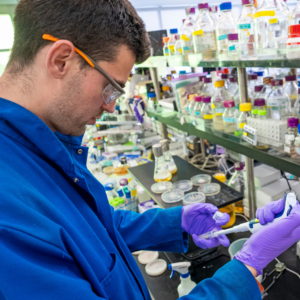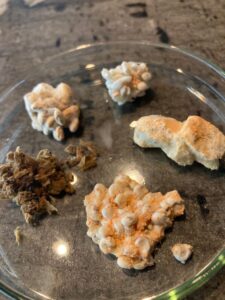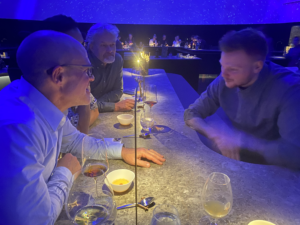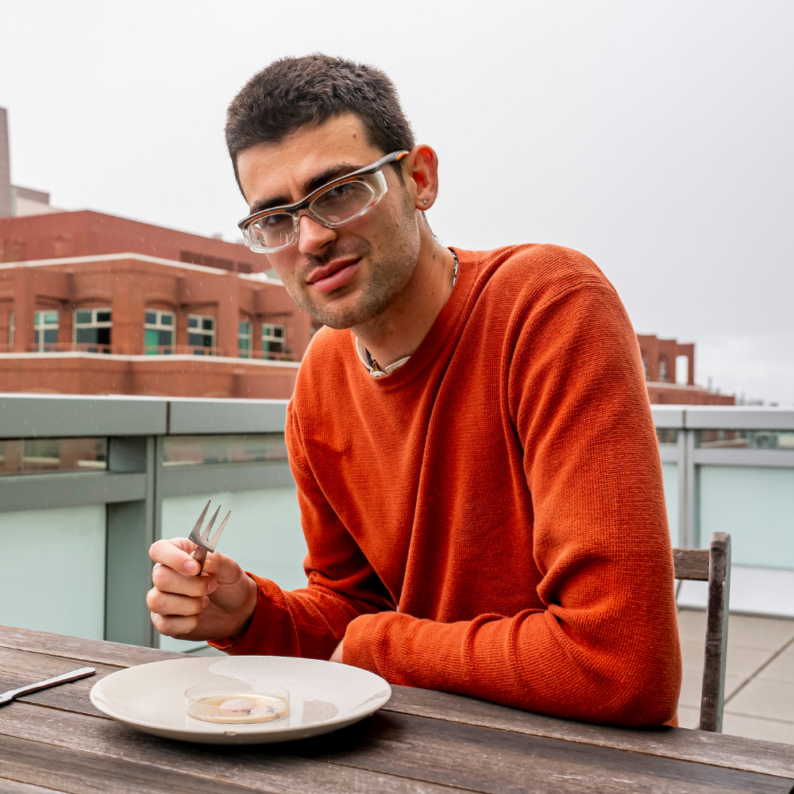In the pursuit of scientific experimentation, different disciplines are often woven together to achieve a larger goal. The neatly packaged result often looks perfectly engineered but behind the success is a story of detours and the unknown. Dr. Vayu Hill-Maini’s career path first appears to be a deliberate weave of scientific disciplines and precise plans. Yet, his journey did not start with academics. He left his birth country of Sweden after high school for the bustling kitchens of New York City, determined to become a chef. Now, with a Ph.D. in Biochemistry & Molecular Biology from Harvard, he’s at the forefront of microbial research in the Keasling Lab, where he unravels the secrets of fermentation, agricultural waste breakdown, and sustainability to create foods that are both delicious and nutritious.
A Journey Begins:
Vayu’s curiosity about food began at home. In his childhood, Hill-Maini recalls the combination of smells and tastes not just fueling his culinary explorations but also connecting him to his own family and their many cultures. With a love for food as his guiding force, he moved to New York City to hone his skills and found his culinary interests evolving.
His pilgrimage to NYC was a testament to his determination and desire to explore the diverse realms of gastronomy and unexpectedly led to a pivot to academia and hard science.
“The foams, the gels, and Ferran Adria at El Bulli were pathways into science. That’s where I realized science was a tool,” he recalls.
The culinary trends of the 2010s that drew focus on the physical and chemical processes of food, now commonly known as molecular gastronomy. The evocative movement took over kitchens across the world blurring the boundaries between laboratories and the kitchen. “It was a very return-to-the-science moment,” he reflects.

When asked about the divide, Vayu can’t identify a definitive transition between his culinary pursuits and where his scientific career began – these two disciplines have always coexisted for him. He does credit his involvement in Harvard’s Science of Cooking course, both as a student and later a teaching assistant, as the formal link between his two fields. The course’s forward-thinking reputation opened up a worldwide network of like-minded individuals with whom to explore the interconnectedness of food and science
Following his Ph.D., Vayu was awarded a Miller Fellowship to research fungi and was hosted at the Joint BioEnergy Institute (JBEI) in the laboratory of JBEI CEO and UC Berkeley Professor of Chemical & Biomolecular Engineering Jay Keasling. This unique fellowship afforded Hill-Maini the autonomy to research the development of nutritional food with fermentation and synthetic biology.
A Chef in A Biofuels Laboratory:
Fermentation is a process that uses microorganisms to break down molecules in an anaerobic environment and is responsible for some of the most popular products at the grocery store; wine, cheese, kombucha, kimchi, and sauerkraut are familiar examples.
However, fermentation can produce much more than tasty flavors and has proven to be very important to the production of lignocellulosic biofuels and the decomposition of biomass. Microbial fermentation is integral to the biofuel production process as it enables the efficient utilization of non-edible feedstocks, contributing to sustainable bioenergy solutions that help mitigate climate change while avoiding competition for resources with food crops.

“Vayu has been working on finding renewable and carbon-conscientious solutions for feeding the world. While he is not working on developing fuels or chemicals, things we would normally associate with JBEI, he is using the same techniques to develop products to make our planet and food more sustainable,” remarked Jay Keasling.
The labs at JBEI provide a fertile ground for Vayu’s ideas to flourish and for his work to have a tangible impact on the scientific community and beyond. Working alongside biofuels researchers has only made Vayu’s mission clearer. Looking beyond food, his work is also transformative to the challenge of agricultural and food waste breakdown. At the heart of his research lies the identification and characterization of microbial strains capable of efficiently breaking down waste. To meet the demand for biofuels, large amounts of plant waste will be produced as a result of the plant-to-fuel conversion. Traditional waste disposal methods often exacerbate environmental effects, but incorporating food production could prove to be an extraordinary alternative.

Hill-Maini’s results and collaborations are now receiving a lot of attention. In the fall of 2021, he was once again back in the kitchen after being invited to work on the Research & Development team at Copenhagen’s two Michelin-starred Alchemist restaurant. He worked with the team to transform his newly developed fungal foods into a specialty course consisting of a solidified rice custard set on top of a gel of plum liquor and fermented Japanese rice wine. The experimental cuisine was an ideal fit for the 50-course meal and immersive experience the BBC recently called “most creative in the world” and was well-received by diners.
The team captured the unique collaboration in a paper recently published in the International Journal of Gastronomy and Food Science. Even with the resurgence of fermentation as a contemporary phenomenon, Hill-Maini appreciates the deep history of his techniques. “I’m just part of a long history of people who have been practicing a deep science for thousands of years across all cultures,” he said with both humility and pride.
